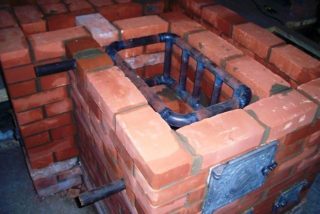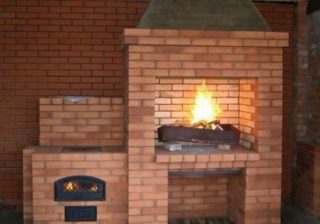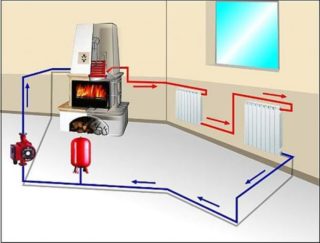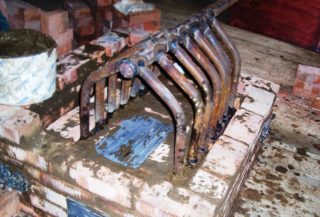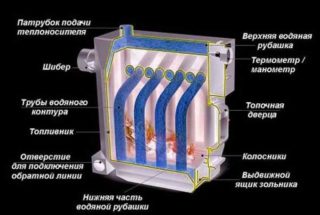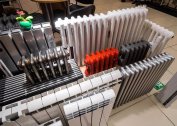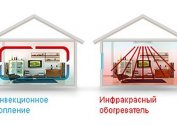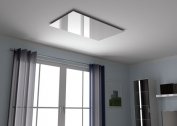For heating a house with a large area, consisting of several rooms, it is worth choosing the most economical option, for example, a stove with a boiler. A modern brick furnace with a water circuit makes it possible to heat all rooms from one point. The heat carrier in it is able to evenly distribute heat and maintain the desired temperature over the entire area. Before buying such an unit, it is necessary to study in detail the principle of its operation, all the pros and cons, as well as the connection method and type of system.
Way of work and design
A brick furnace with a water circuit for heating a house works according to the standard principle. To install it, it is necessary to create a system for water heating, with the help of which heat comes from the furnace walls and heating radiators connected to the main circuit. Contour pipes are connected to the boiler or to the register built into the furnace. The heat carrier is heated by passing through a hot register, then it goes to pipes and radiators.
After passing through the circuit, the temperature of the coolant decreases and it again enters the heat exchanger, where it is reheated. For perfect fuel circulation, a special pump is built into the circuit. An important element of the system is the expansion tank. If we are talking about a closed system with a sealed circuit, such an element can be put anywhere. As part of an open system, the tank is placed at the highest contour point, it can be an attic or another room.
Expansion tank - capacity for excess heated coolant. It has a diverse design, size and volume, it must be selected taking into account the type of heating system and the amount of heat carrier.
Pros and cons of heating with a water circuit
Water-fired brick stoves used to heat a private house have their advantages and disadvantages. They need to be taken into account when choosing a similar device for a bathhouse or a living room. Choosing the right model is necessary taking into account the specific parameters of the house. The best option would be a long-burning furnace, capable of working for 12-14 hours after one fuel tab.
The list of advantages of a furnace with a water circuit includes:
- economical fuel consumption compared to systems operating on other energy sources;
- the ability to install a furnace complete with other heating systems;
- the ability of the stove to fit into any design project for interior decoration.
Of the minuses of such units, the need to heat the furnace in winter in the continuous furnace mode is noted. Otherwise, the rooms will not warm up to the optimum temperature.
A furnace with a water circuit is not an automated system, so fuel for heating in some models of units must be loaded in manual mode.
Types of systems
A brick oven with a water heating boiler, made by yourself or purchased, can work on a system with forced or natural circulation. Each of the two types has its own characteristics and differences that must be taken into account.
Forced circulation
This type of system is supplemented by a circulation pump, which is responsible for moving the heat carrier through the chimneys.By connecting the system to electricity, the pressure level in the radiator can be controlled by valves. It also makes it possible to reduce the amount of fuel for heating the coolant. Forced circulation is quite economical, but its main drawback is the dependence on power supply. In the event of a power outage, it will not work.
Natural circulation

A system with natural circulation works based on the application of the laws of physics. During operation, the coolant moves through the pipes due to differences in the density of cold and hot water. The main advantage of the system is its non-volatility, which is why it is often created in homes where power outages occur. Among its shortcomings, the need to use heavy metal pipes, for example, cast-iron, which are difficult to mount, is noted. Also in the system there is no way to adjust the heating level of each room.
A stove or a fireplace with a water circuit can be made of cast iron, steel or brickwork. A suitable option is chosen by the owner of the house. During the selection, the total area of the rooms to be heated, the power of the device, the amount of space allocated for the furnace, the location of each circuit element, the functions of the unit and its design are taken into account. In addition to these parameters, you need to remember the need to install a special foundation under the stove.
Connecting the stove to a water heating system
To fully connect the device to the general system, you will need to purchase a coil in the stove for water heating. It is installed inside the firebox. When choosing it, the thickness of the walls of the furnace is taken into account, if we are talking about a device that works on wood, the walls can be thinner.
Units that are heated with coal briquettes can have denser walls. This condition cannot be ignored, otherwise the boilers will quickly burn through, and they will have to be replaced before the expiration of the set life.
Calculation of power and size of heat exchangers
The power of the heat exchanger depends on the materials from which it is made. If the part is cast iron, the models of the MS-110-300 and MS-90-300 series will be the best choice. Due to their small size, they easily fit into the furnace, their heating area for each rib will be 0.14-0.16 m2. Given these numbers, you can calculate how many sections are needed to heat each circuit. For every 10 square meters of the room you will need 1 kW, equal to about 0.1 m2 of the total heat exchanger heating.
How to make a do-it-yourself oven
Sometimes it becomes necessary to equip a brick oven with your own hands and build it into a niche or install it on a square or rectangular foundation. First of all, they make markings for the furnace and fill the foundation. After it dries, lay two rows of masonry made of brick according to the ordering scheme in order to smooth the uneven foundation and make the foundation for the unit. Next, you need to lay out the rows on the clay mortar and finish the calculation, taking into account the thickness of the joints between the rows in the process.
When the case is ready, it remains to install the doors, firebox, hob, heat exchanger and other details. After completion of the work, the furnace must be fully heated and its performance checked.
Drawings for the furnace can be developed independently or seek help from professionals. In the absence of experience, it is better to entrust this work to specialists who will prepare a detailed scheme taking into account the requirements for the heating system and a specific room. In this case, the finished unit will fully comply with safety requirements and criteria for the heating system.
